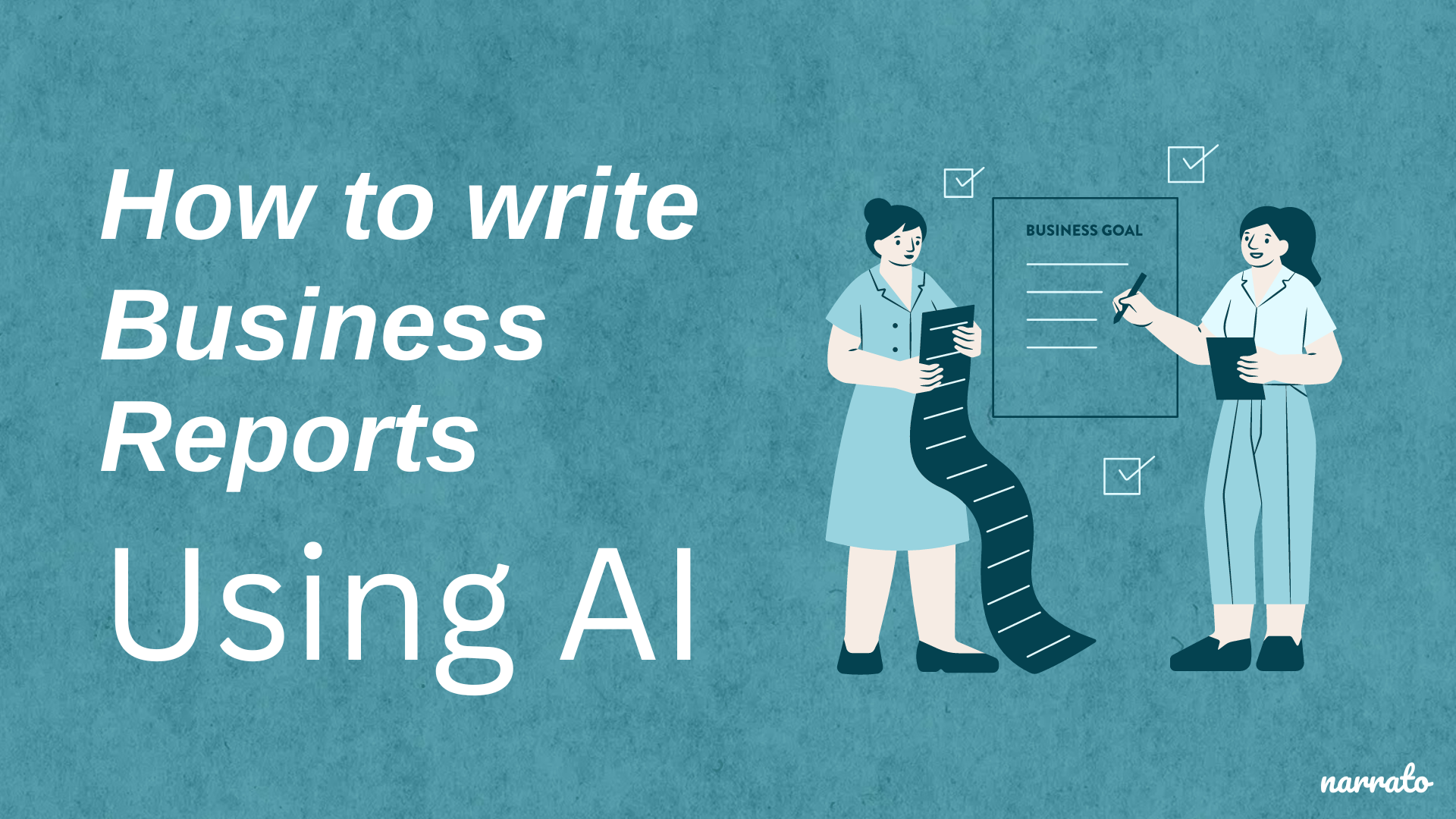Crafting business reports has always been a bit of a chore, right? It’s that task that eats up time, requires meticulous detail, and often has people scrambling at the last minute to meet deadlines. What if there was a tool that made this easier? Yep, we’re talking about AI. An AI writing assistant can shave hours off the time you spend compiling data, structuring information, and polishing the language and streamline the business report-writing process. In this blog, we’ll explore some practical ways you can use AI to write business reports.
3 ways to use AI for writing business reports
- Create business reports using AI article writer from documents
- Create business reports using the AI summary generator
- Create business reports using the AI content repurposing tool
Tips for writing business reports

What are business reports?
Business reports are structured documents that provide detailed insights into various aspects of an organization’s operations. They play a critical role in helping decision-makers and stakeholders understand what’s happening within and outside the company. In essence, they translate complex information into easily digestible formats, helping businesses make informed decisions and stay competitive.
There are many different types of business reports that can be used to communicate information and insights. Some of the most common types include –
- Informational Reports: These reports present data without offering suggestions or analysis. They typically include reports like monthly financial statements, sales figures, or performance reports.
- Analytical Reports: Unlike informational reports, analytical reports delve into data analysis and provide recommendations. They explore questions like why sales are down and the best strategies to improve figures.
- Research Reports: Companies use these reports to explore specific topics comprehensively. They often combine findings from various sources to provide insights into market trends or customer preferences.
- Progress Reports: Tracking the progress of a specific project, these reports are used internally to update stakeholders on ongoing work and any challenges that need addressing.
- Feasibility Reports: Before starting a new project, businesses often prepare feasibility reports to evaluate potential risks, benefits, and the likelihood of successful completion.
Components of a business report
A well-structured business report typically includes several key components. Understanding these elements can help you draft reports that effectively communicate the necessary information to stakeholders –
- Title Page: The title page covers the basics – the title of the report, the author’s name, and the date. It sets the stage for the report and provides context at a glance.
- Table of Contents: This section provides an overview of the report’s structure, helping readers navigate quickly to areas of interest.
- Executive Summary: This is a concise summary of the report’s purpose, main findings, and recommendations. It can be a standalone section for busy executives who need the gist without diving into the full report.
- Introduction: Here, you’ll have to set the context for the report, and outline the main objectives and scope.
- Background: This is where you provide background information on the topic you’re discussing to help readers understand the context better.
- Methodology: This section explains how the information was gathered, including the methods and processes used to conduct analysis or research.
- Findings and Discussion: Here, you present and discuss the key findings of the report. Use appropriate data visualizations like graphs and charts to make the information easier to digest.
- Conclusions and Recommendations: Here, you can offer conclusions derived from the findings and suggest actionable recommendations. This should guide decision-makers on the next steps.
Now that you know the basics of a business report, let’s explore how AI can help you create one.
3 ways to use AI for writing business reports
AI writing tools can change how you compile and create business reports, making the process more efficient. A Statista survey found that for many users, the biggest perk of using AI tools is the valuable time they save. Instead of spending hours manually collecting and formatting information, you can rely on AI to take care of these tasks for you.
Here are three ways to use AI for writing business reports –
1. Create business reports using AI article writer from documents
One of the easiest ways to create your business reports is by using an AI article writer to repurpose your documents into polished business reports. AI-powered tools can sift through your data, pulling out key insights and presenting them in a clear, concise format. This not only saves you a ton of time but also ensures consistency and accuracy. Plus, you can always ensure that the final report can be tailored to your preferred tone and style.
Here’s how it works 👇
Open the AI article writer from documents template from the AI Content Assistant on Narrato.
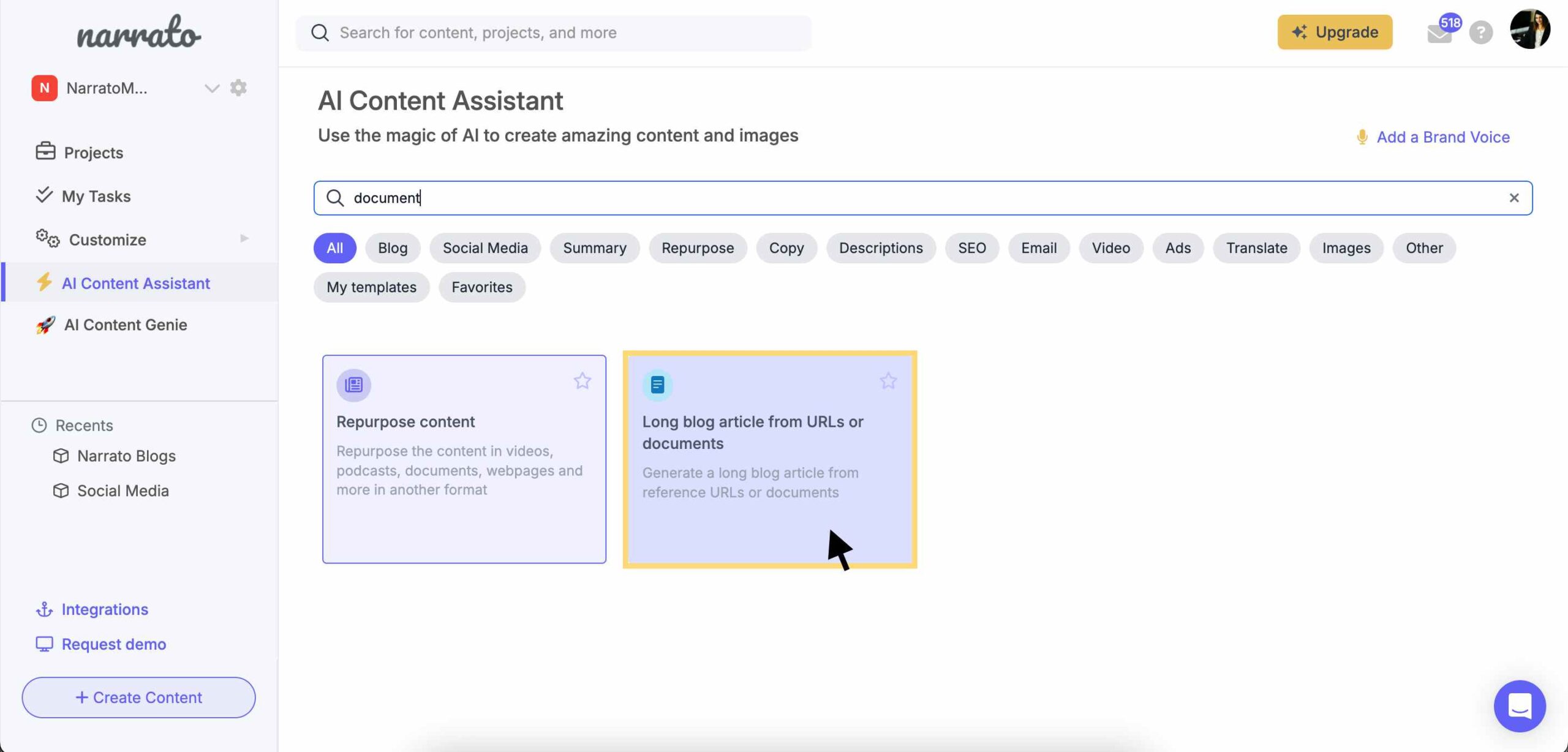
You’ll be prompted to provide the title of your business report. If you’re not sure about the title, you can always take the help of an AI topic generator to get different title ideas. (Check out this blog on AI topic generator to learn how it works). You’ll also be given the option to upload the document(s) here.
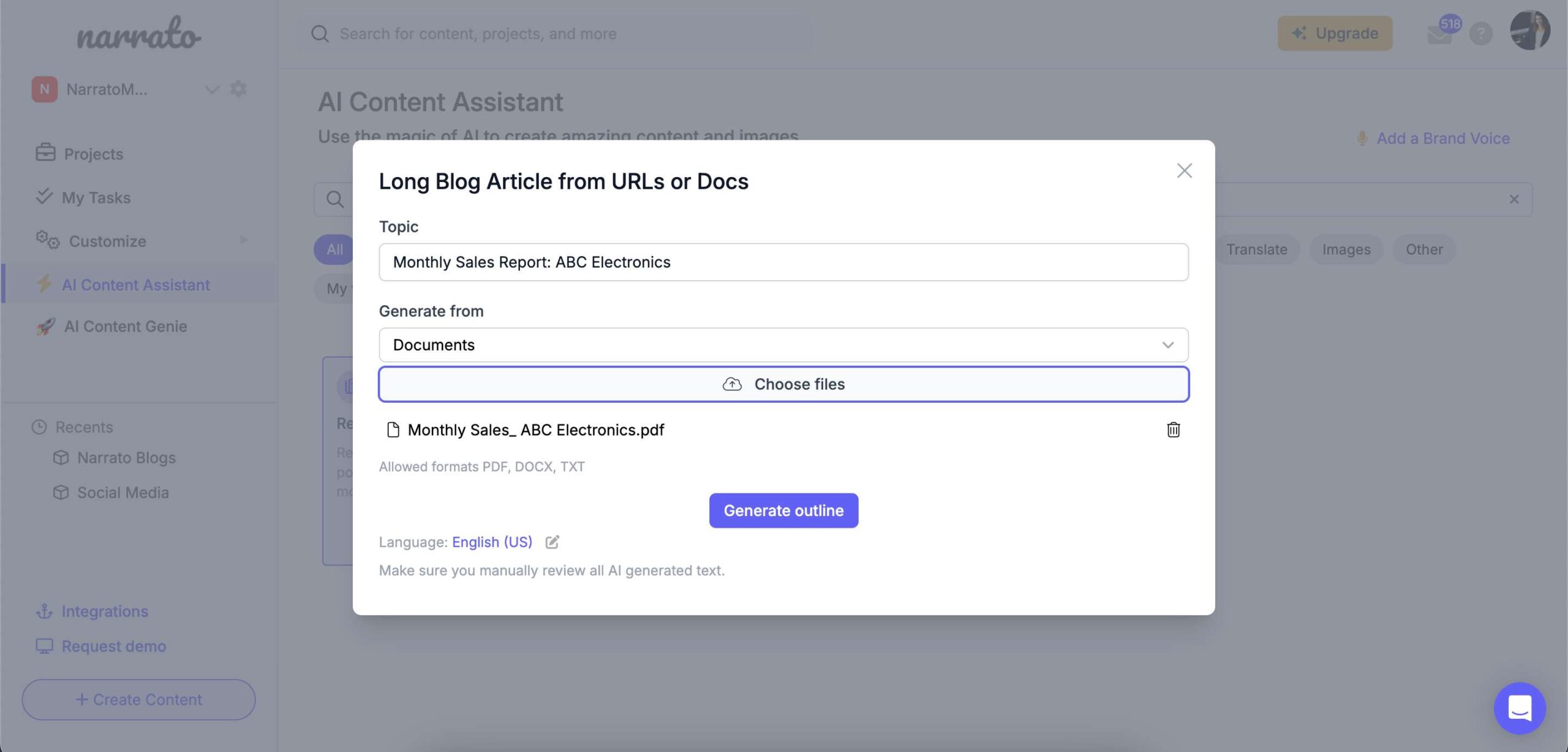
The AI tool will use the information provided in the document to create an outline for the business report. It will organize the extracted content into logical sections and add necessary elements like an executive summary or conclusions. You can edit this outline to include any missing sections or regenerate it if needed.
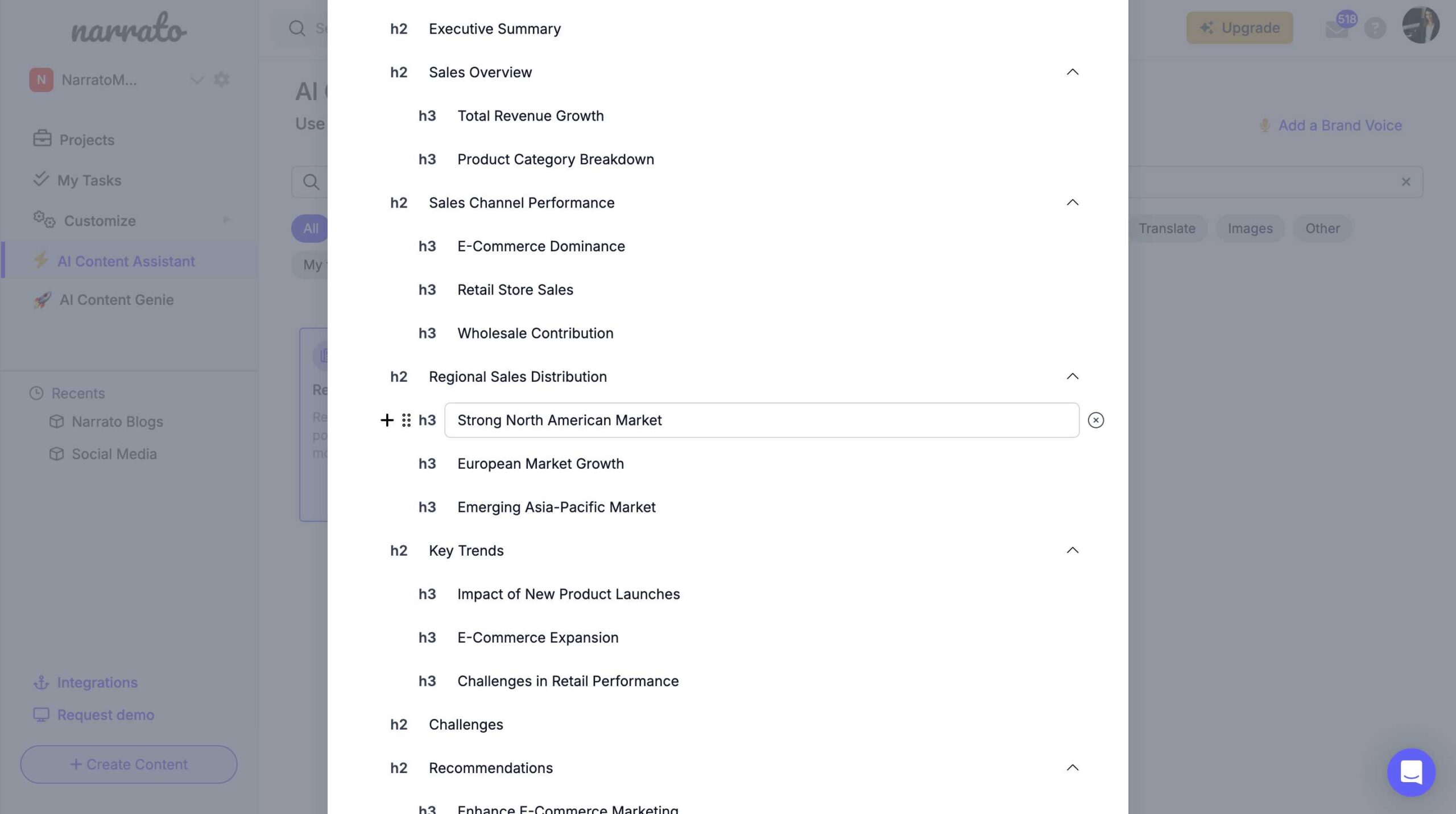
You can also prompt the AI tool to add specific keywords to the business report. Besides that, you can customize the tone and length of the content.

Once you’re done, click ‘Generate’ and you’ll get your AI-generated business report in seconds.
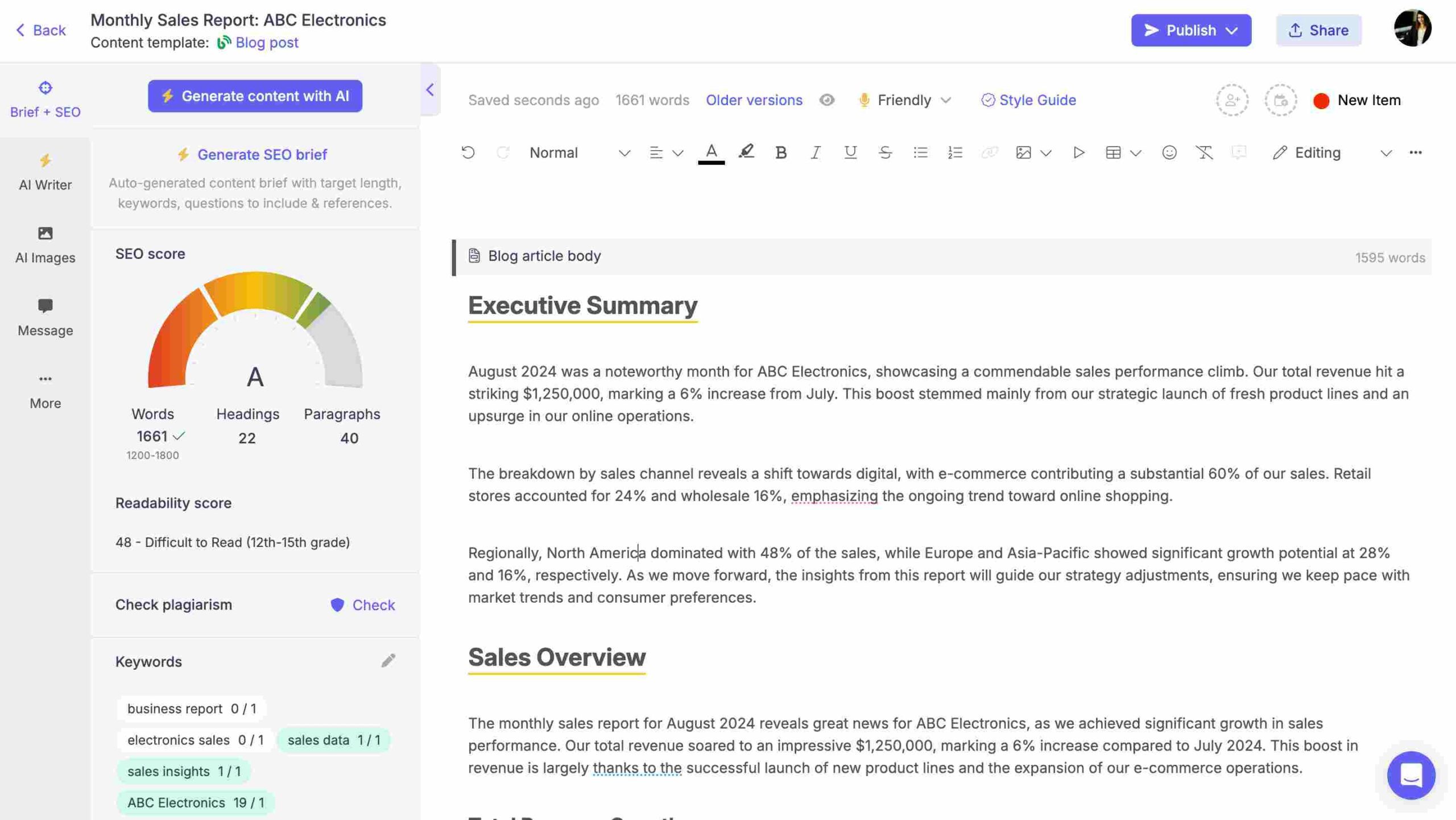
The final step is to include any charts or illustrations that will make the information easier to understand. AI-powered data visualization tools like Infogram can help with that too. With this, you can create charts, reports, infographics, and more, and embed them on your business reports.
2. Create business reports using the AI summary generator
Another way to create business reports is by summarizing the key points from your data sources and documents. The goal of your business report is to provide a digestible overview that allows stakeholders to quickly grasp the core message without sifting through unnecessary details. An AI summary generator can make this entire process a lot easier. It can distill large volumes of text or notes into concise summaries.
Here’s how it works 👇
Open the AI summary generator from the AI Content Assistant. You’ll find two templates – ‘Summarize text’ and ‘Summary from notes’.
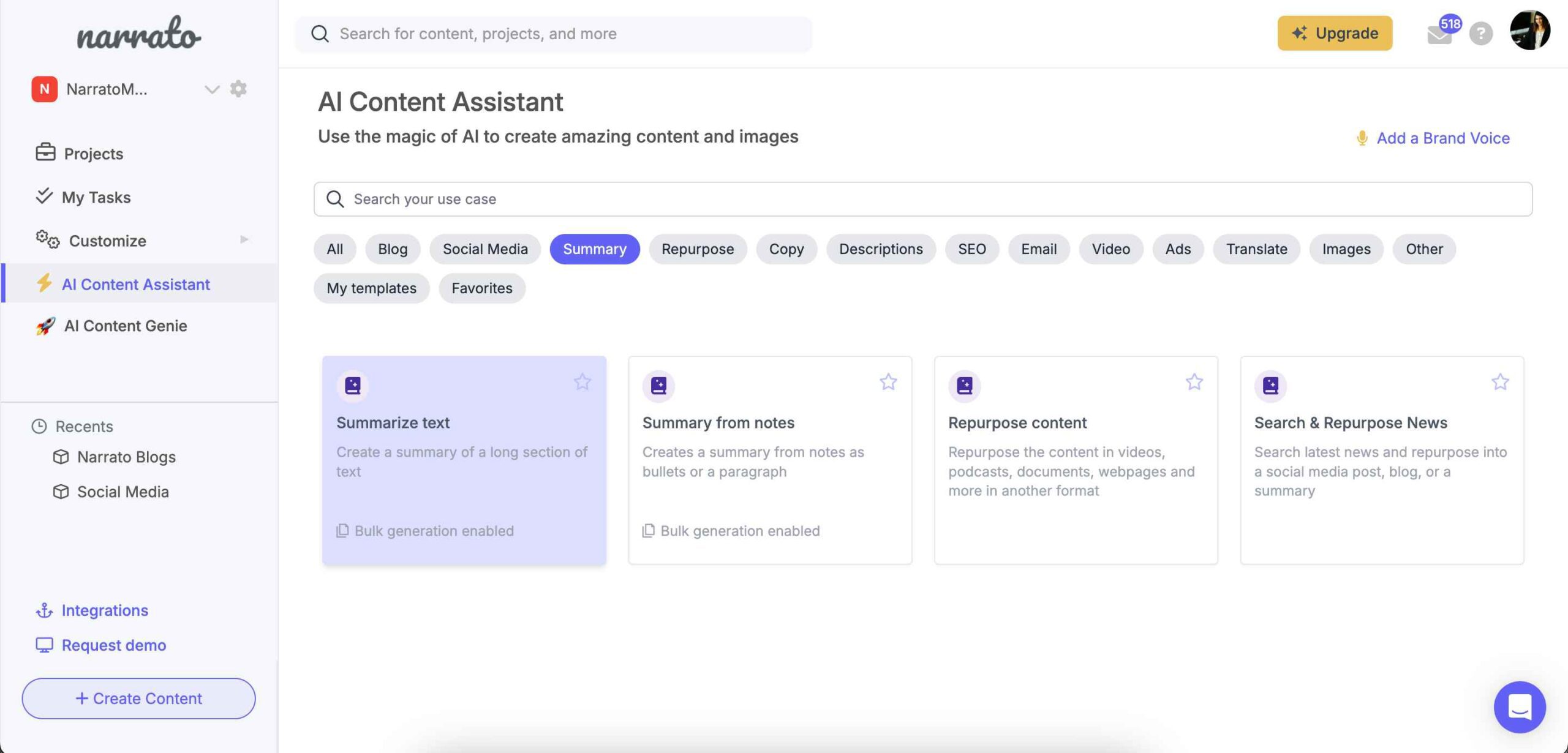
With ‘Summary from notes’, you can simply paste your text to get the content you need. The ‘Summarize text’ AI template gives you options to add text, file, or even a URL.

Once you’ve selected your preferred method for inputting the source content, go ahead and fill out all the remaining fields, including summary length, format (paragraphs, bullets, or paragraphs & bullets), and tone.
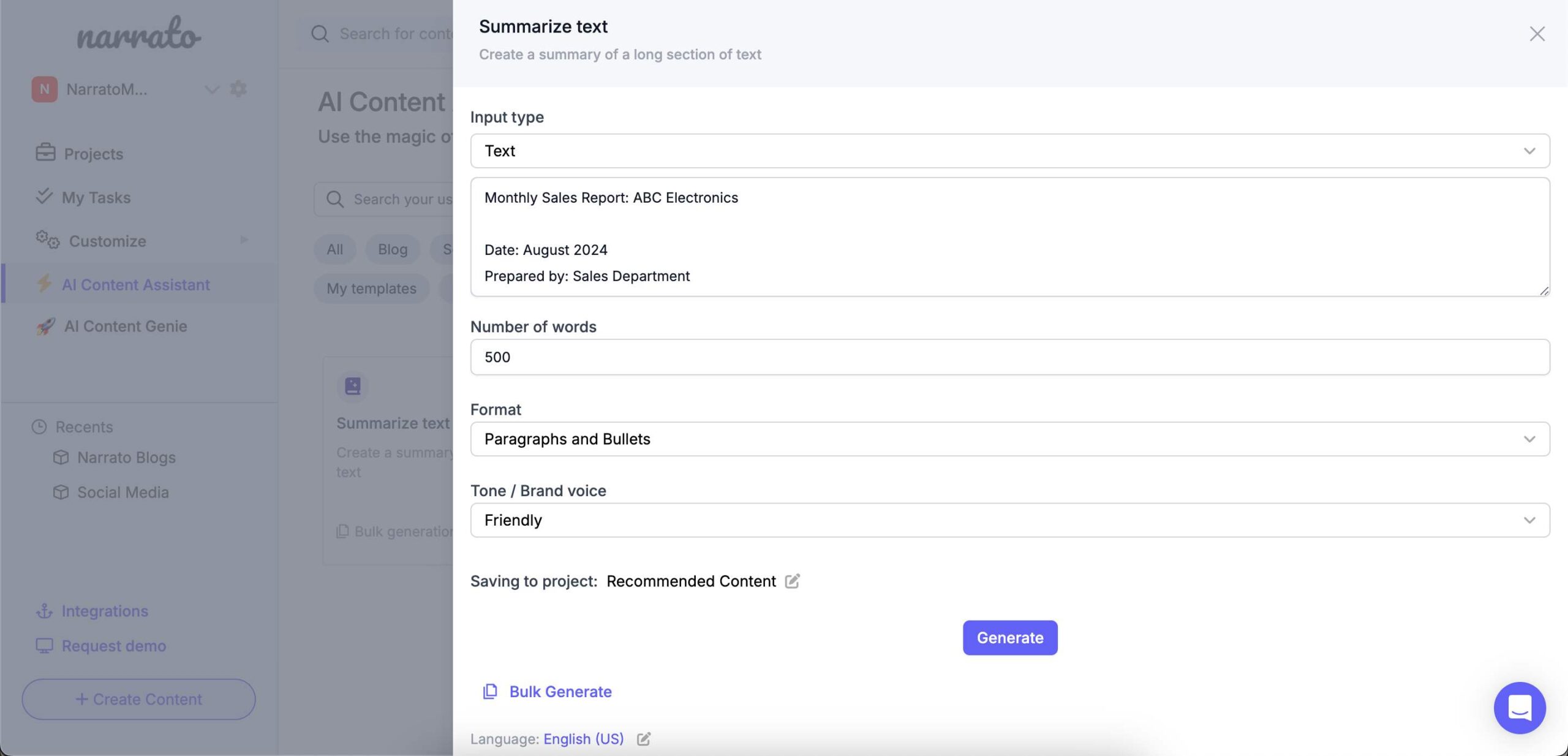
Click ‘Generate’, and your AI-generated business report will be ready in seconds.
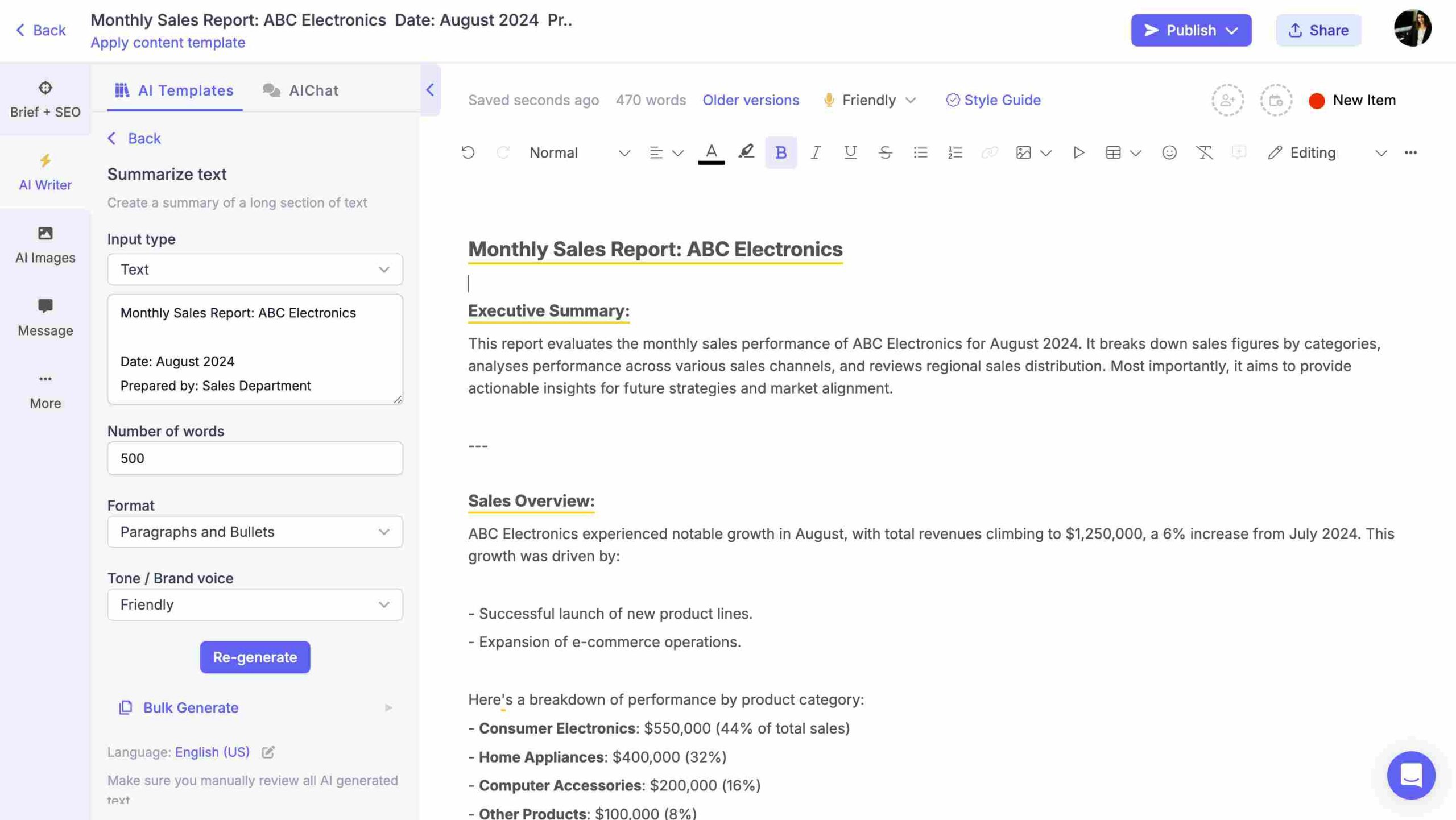
3. Create business reports using the AI content repurposing tool
Content repurposing is a powerful way to adapt content across formats. Many businesses have existing content like blog posts, product brochures, presentations, and videos that can be repurposed into comprehensive business reports. An AI content repurposing tool can make this process even more efficient and faster.
Here’s how it works 👇
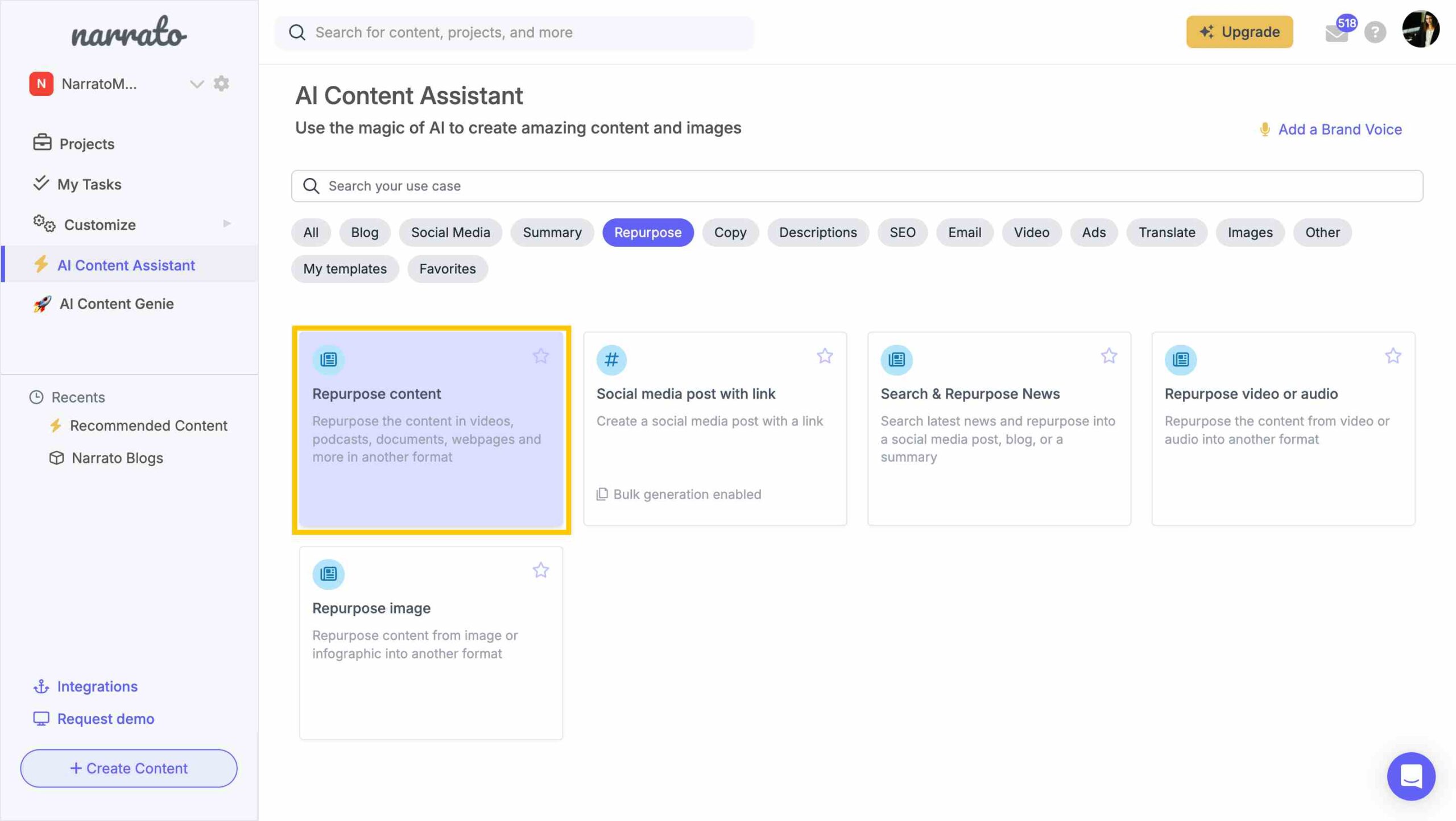
Choose the content you want to repurpose into a business report. Narrato’s AI content repurposing tool gives you the option to repurpose documents, videos, images, webpages, podcasts, blogs, press releases, presentations, newsletters, and any other text.

For the output content, specify that you want to repurpose it into a Business Report. Fill out all the other input fields, and add any additional instructions for repurposing content.
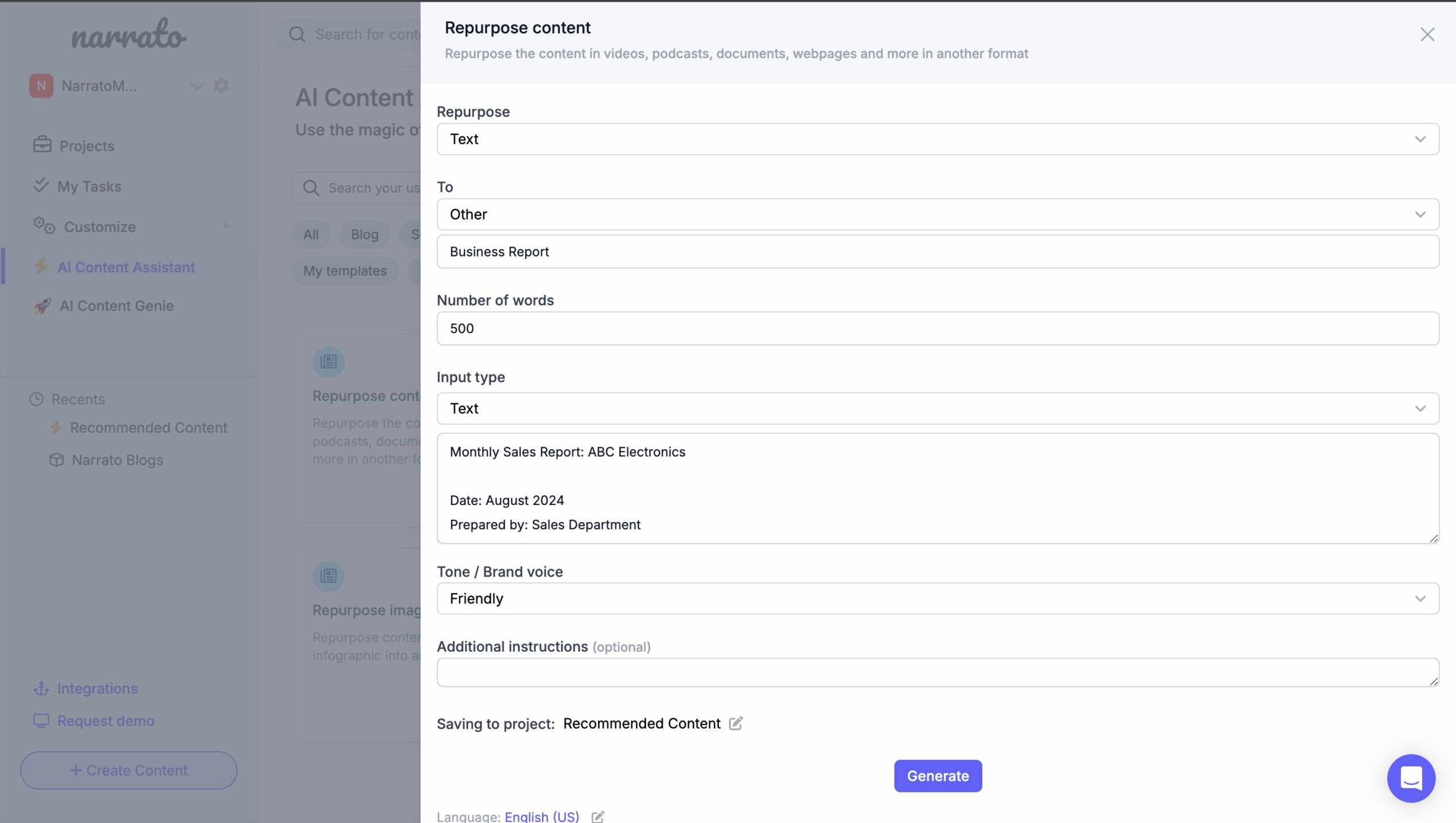
Click ‘Generate’ to get your repurposed content in the form of a business report.
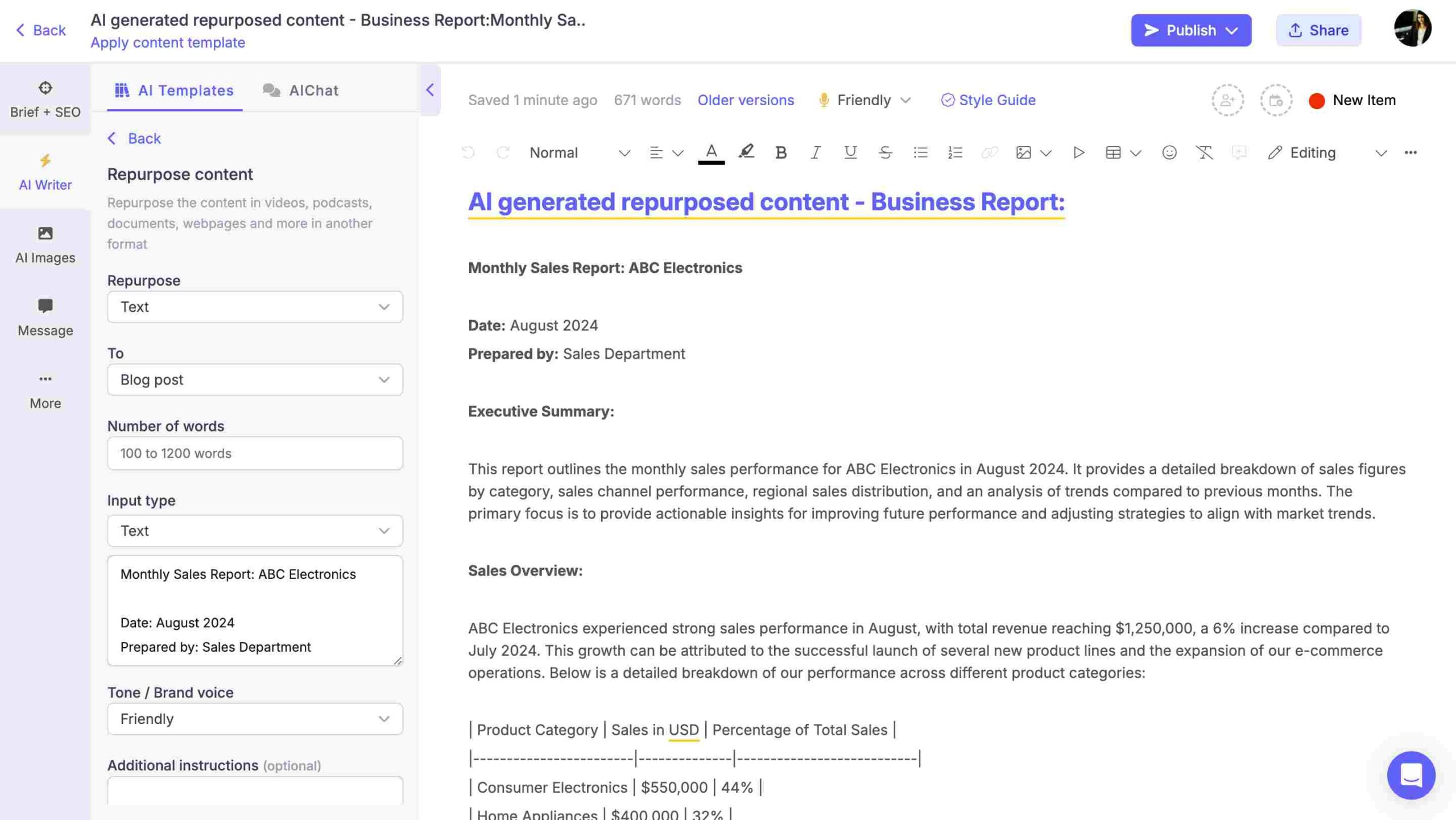
The AI will automatically compile and format your information into a polished business report, ready for presentation or review.

Tips for writing business reports
Writing a business report may seem challenging initially, but with some planning and the right tools, you can craft an impactful report that effectively communicates your message. One key aspect often tied to project management is financial tracking in project management, ensuring that financial data is properly represented. Here are some tips for creating good business reports –
1. Do thorough research
Before you start writing, gather all the necessary information. This means plowing through company records, industry reports, and any other sources that you can use to create the business reports. Thorough research ensures that your business report is well-grounded in facts and provides a comprehensive view of the topic.
2. Create an outline before starting
Create an outline before writing your business report sets a clear path, and ensures your thoughts are well-organized and coherent. Start by defining the main sections: an introduction to present the purpose, body content to discuss key findings and data, and a conclusion to wrap up insights. Whether you’re structuring a report or planning to write a business proposal, an outline helps organize critical details effectively. By outlining first, you make the writing process smoother and more efficient, ultimately producing a high-quality report.
3. Choose a unique title for the business report
Your title is the first thing that grabs the reader’s attention, so make it count. It should be descriptive yet concise, giving the reader a good idea of what to expect. Avoid vague titles. Instead, aim for something that clearly reflects the report’s content.
4. Add some good illustrations
Visuals can transform a dull business report into an engaging narrative. Adding charts, graphs, and infographics can make complex information more digestible and highlight key points effectively. Depending on the data type, choose between pie charts, bar graphs, or line graphs to best represent your information. Always provide context by labeling charts and diagrams, so readers understand what they’re seeing.
5. Add your conclusion (with recommendations, if any)
Conclude your report by summarizing the key points and insights. This section acts as a wrap-up and may include recommendations based on your findings, which can serve as actionable steps for the reader. Leave the reader with a strong final impression that highlights the importance of the information shared.
Wrapping it up
By using the methods and tips detailed in this article, you’ll be able to speed up the process and produce professional-looking business reports. Plus, AI can help you format your reports consistently, which improves their readability and impact. So, whether you’re compiling analytics or looking to repurpose existing content, AI-powered solutions can take your business report writing to the next level. Try it out for yourself today.


